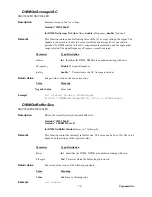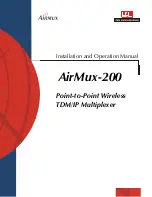
69
Signametrics
DMMArmAnalogTrigger(0,80,1.5);
while( ! DMMReady(0));
// Wait for capture
for(i=0; i < 80 ; i++)
j = DMMReadBuffer(0, &Buffer[i]);
DMMArmTrigger
2060
SMU2064
Description
Arm DMM for external trigger operation.
#include "SMU2060.h"
#include "SMU2060.h"
int DMMArmTrigger
(
int
nDmm,
int
iPostTrig
)
Remarks
Setup the DMM for external hardware trigger mode (input at DIN7 connector).
Following reception of this command the DMM continuously makes measurements,
storing them in a circular buffer, while waiting for the for the selected trigger edge. All
measurements are made at the currently set Aperture and Read Interval. On reception of
the selected trigger edge the DMM makes
iPostTrig
samples at the currently function and
range, storing them to the buffer. The result is a buffer containing both, pre-trigger and
iPostTrig
post-trigger samples. The total number of which is limited to the buffer size
(120 or 80 depending on set Aperture. See
DMMArmAnalogTrigger
for details). With
the exception of the
DMMReady
and
DMMDisarmTrigger
commands, following the
issue of the
DMMArmTrigger
command
,
no other function should be sent to the DMM
prior to reading the captured data. This function is usable for none composite
measurements such as VDC, VAC, Ohms, IAC, RTD and IDC and Leakage. Following
completion of the capture process, Use the
DMMGetTriggerInfo
function to get
information related to the operation. The Trigger Edge polarity can be set with the
DMMSetTrigPolarity
function.
The width of the trigger input must be at least as wide as the selected Aperture and/or
Read Interval, whichever is greater.
Following
DMMArmTrigger
, use the
DMMReady
to monitor completion of the
capture process. When the DMM is ready read the buffer using DMMReadBuffer or
DMMReadBufferStr functions. Make 120 or 80 read operations to read both, the pre-
trigger and post-trigger (iPostTrig) samples. Following trigger operation, once
DMMReady returns TRUE, it should not be called again since it prepares the buffer for
reading when it detects a ready condition. Other related functions include,
DMMReadBufferStr, DMMSetReadInterval, DMMSetSync, and DMMSetAperture.
Parameter Type/Description
nDmm
int
Identifies the DMM. DMMs are numbered starting with zero.
iPostTrig
int
The number of samples the DMM takes following a trigger. This
value must be between 1 and 80 or 120 depending on set resolution.
Return Value
The return value is one of the following constants.
Value Meaning
DMM_OKAY
Operation successfully terminated
Negative Value
Error code.
















































